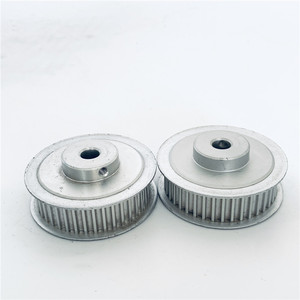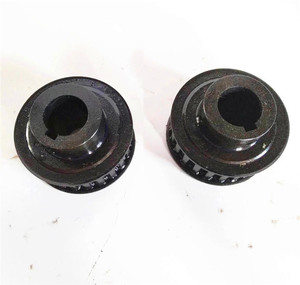
All categories
Featured selections
Trade Assurance
Buyer Central
Help Center
Get the app
Become a supplier

(7471 products available)














































Industrial timing pulleys are crucial components in machinery with timing belt systems, assuring precision transmission of motion in varied industrial applications. Pulleys}} have differing teeth configurations and pitches and thus suit diverse belt types and operational needs.
These types include:
Synchronous Timing Pulleys
Synchronous timing pulleys feature grooves that match the teeth of synchronous belts. They ensure that the belt and pulley system operate together smoothly, giving precise and efficient motion transfer. Because of their precision, they are frequently applied where exact movement and alignment are required, such as in CNC machines, robotics, and high-speed manufacturing equipment.
HTD (High Torque Drive) Pulleys
HTD pulleys are designed for better torque transmission and reduce backlash. Their tooth profile allows for higher loads and greater belt engagement surface, leading to higher durability. HTD systems are often used in heavy-duty applications, such as lathes, milling machines, and industrial printing equipment, where increased power transmission and reliability come first.
GT (Gates profile) Pulleys
The GT pulley system by Gates has an optimized tooth form for better load carrying capacity and reduced wear on the belt. This system promotes power transmission efficiency for industrial applications. It is used in many agricultural, automotive machining, and production equipment.
XL (Extra Long Life) Pulleys
XL pulleys are served with extra-large timing belts for long life and durability. They are ideal for low-speed, high-torque applications. XL pulleys and belts are used for conveyor systems, textile machinery drives, and other heavy-load industrial situations requiring sustained durability.
Delrin Pulleys
These are produced from Delrin-acetal resin and are thus a tough, durable material that does not rust. Due to its strength, Delrin is also very resistant to wear and tear. In addition, due to their material characteristics, these pulleys operate quietly and are very lightweight. They can be employed for drive systems and fit into pulley/belt systems, such as the Gates GT3, that require greater dimensional precision.
The material chosen for timing pulleys affects greatly their strength, durability, performance, and resistance to wear. Their designs have evolved to accommodate different operational needs and load conditions optimally.
Aluminium Alloys
They are lightweight, corrosion-resistant, and strong enough for most belt drives. Leichter than steel or iron, they carry less load, thus saving more energy in the process.Transmission is done faster with greater efficiency and requires lower energy costs. Common in robotics, aerospace, and machine tools, they drive the system while reducing corrosion.
Steel with PTFE Coating
PTFE-coated steel pulleys are provided to give steel's strength and wear protection. The PTFE decreases friction and protects against chemical corrosion, thus extending the life of the pulley. It is often used in extreme wet or chemical environments in the textile industry, food processing, and conveyor systems.
Rubber-Covered Pulleys
Rubber-covered steel or aluminum pulleys absorb shocks and dampen noise. The elastic nature of rubber permits variations in load and movement, preventing belt slippage and wear. This is ideal for packaging machinery, conveyor systems, and handling brittle materials requiring quiet and cushioned power transmission.
Composite Materials
The composites have been designed to combine strength, and flexibility: they resist wear, noise, and heat. Since Composites can be easily constructed into complex forms and their custom characteristics, such as the stone, noise, and heat that they have, they make them ideal for precision applications. These can be employed in medical equipment, aerospace applications, or other advanced systems requiring lightweight, minimal noise, and heat generation.
The design of industrial timing pulleys has to meet both functional and mechanical as well as aesthetic requirements, especially for the intended application. Some key design considerations include the following:
Tooth Profile
The tooth profile must match the belt type to ensure proper meshing. This ensures that the load is distributed evenly and that wear is minimum. Synchronous buck teeth designed for high torque or low backlash applications enhance pulley performance in specialized industrial applications.
Belt Width and Length
Belt width and length determines the pulley size and ensures that the system has proper load-carrying capacity and level of stiffness. A broad belt ensures that power is transmitted through greater surface area, whereas a longer belt allows greater distance within a machine. The balance offers optimum performance and within for permissible limits of pulley size.
Material Selection
In part determined by the application and operating conditions, the material affects pulley strength, wear, and thermal expansion. A compromise between weight and strength must be struck to give optimal performance. Consideration for the purpose is given to mechanical and thermal resistance, with the final purpose being consistency in the mechanical system.
Mounting and Adjustability
Conversely, the ease of installation and adjustment are critical. Pulleys with quick-mounting or adjustable features allow for belt tensioning and replacements in minimal time, thus reducing downtime during maintenance and increasing time efficiency in industrial settings.
The growing need in the industry for greater efficiency and specificity drives the development of high-performance customization options for industrial timing pulleys. Custom timing belts and pulleys can be adjusted for size, material, and tooth profile and in other ways to suit specific applications.
Size and Scaling
Adjustments for the size of the pulley, such as diameter and width, will ensure that the pulley fits for a particular application. As a result, the scaling limits the range of speeds and loads: it customizes size to exploit the range of operational parameters fully.
Variable tooth profiles
Tooth profiles, such as the type of gear teeth or the tooth shape, can be molded to increase efficiency or reduce belt slippage. Variable tooth pitches ensures that the pulley system will match the specific belt more precisely, which is effective for mechanical advantage during certain load or speed conditions.
Material Composition
These can be adjusted to the degree of application. For example, coated steel pulleys have treatment to enhance corrosion resistance, such as for the steel or aluminum base. This can achieve greater durability and noise emission, less heat generation, and better energy efficiency by varying the materials used.
Finish and Coatings
The surface finish of pulleys can be adjusted to affect their wear resistance, friction coefficients, and thermal behavior. Coatings such as PTFE or rubber increase the pulley lifetime in environments that cause excessive heat or chemicals. This also allows for a quieter operation, thus limiting wear on adjacent components.
Modular Designs
Many modern pulleys have been structured to allow changes in tooth sections or pulley materials without replacing the whole system. This flexibility makes a much easier upgrade to meet changing operational demands, whereby only particular components are swapped out.
When selecting Industrial Timing Pulleys, there are various parameters to consider; hence, it becomes so crucial to choose the right one. Several key factors come into play when making this decision. They include the following:
Belt Compatibility
Industrial timing pulleys must be compatible with synchronous belts since each has a particular tooth type; thus, the pulley and belt must match to ensure a proper fit. Matching the belt and pulley minimizes wear while increasing transmission efficiency. Such ensures they work together and peak seamlessly within the mechanical system, achieving that without compromising elasticity or mechanical slippage.
Load Bearing Capacity
The pulley must sustain mechanical loads that come from the application. A higher load-bearing pulley is required for heavy-duty, low-speed, or operations requiring high torque. On lighter machinery, lower load-bearing pulley is just okay. Using a properly rated pulley avoids system failure and therefore optimizes constant performance for continued use under tough conditions.
Durability and Environment
The operating environment determines pulley material and durability. Corrosive, high-humidity, or extreme temperature environments need materials that are resistant to wear, such as coated metals or composites. More heat-resistant or low-friction surface pulleys are required in applications that generate heat. This consideration decreases the possibility of system failure and undesired downtime within the industrial setting.
Precision and Misalignment
Normally, Precision becomes very important in applications such as CNC machining or robotics, where timing is everything. Quite a close fit between the pulley and belt reduces the belt's slippage and wear. However, misalignment can be often corrective with adjustable mounts, which may not further limit their system's accuracy, particularly in precision-based industries fitting up with misalignment correction features.
Ease of Installation
The ease of installing and maintaining timing pulleys has a great impact on the selection. Certain pulleys have quick-release or easy-adjust mounting features that facilitate ease of belt tensioning and replacements. This helps reduce downtime associated with maintenance; therefore, easier installations mean fewer interruptions for the operating system.
A1: The main function of these timing pulleys relates to power transmission efficiency. The main belt elasticities are eliminated by timed pulleys, which enhance the belt-fitted mechanism's accuracy and efficiency by synchronizing the belt's motion with its pulleys to achieve proper meshing. This promotes optimal energy transfer with a minimum wear-out of system components.
A2: Industrial timing pulleys are commonly used in CNC machines, robotics, printing presses, and textile machinery. Other common uses include conveyor systems, medical equipment, and aerospace components. In mechanical systems, accuracy in motion transmission is required for the pulleys to perform their duties in the most effective manner.
A3: The pulleys are selected based on belt compatibility, load-bearing capacity, durability, and ease of installation. It is also important to consider the operating environment. The operating parameters must be ensured to relate to the timing pulley characteristics to minimize the possibility of failure.
A4: Industrial timing pulleys do not require much maintenance; however, regular checks of the pulleys and belts, along with lubrication of moving parts, is a must to reduce friction and wear. Further, environmental factors like handling dust or moisture that may cause corrosion or improper wearing should be dealt with timely so the pulleys last and perform effectively.
A5: Industrial timing pulleys comprise steel, aluminum, rubber, and composite materials. Each of these materials have their own merits and demerits and are selected depending on the load, speed, and environmental conditions of the applied industry. For this reason, these materials have been tried and tested for durability, efficiency, and corrections to misalignment in the industrial setting.